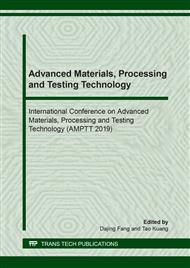[1]
Y. Wang, X. Hu, T. Huang, C. Tian, Thermodynamic optimization and calculation of the LaCl3–-MgCl2 system, Asian J. Chem., 26 (2014) 1655-1657.
DOI: 10.14233/ajchem.2014.17315
Google Scholar
[2]
Y. Wang, Y. Sun, Thermodynamic assessment of EuCl3–MgCl2 and EuCl3–BaCl2 systems, Int. J. Thermophys., 32 (2011) 1942-1949.
DOI: 10.1007/s10765-011-1014-y
Google Scholar
[3]
Y. Wang, Y. Sun, Thermodynamic assessment of PrCl3 - CaCl2 and NdCl3 - CaCl2 systems, J. Phase Equilib. Diff., 31 (2010) 421-424.
DOI: 10.1007/s11669-010-9780-y
Google Scholar
[4]
Y. Wang, G. Shao, S. Li, Y. Sun, Z. Qiao, Phase equilibria calculation of LaI3-MI (M=Na, K, Cs) binary systems, J. Rare Earths, 27 (2009) 300-303.
DOI: 10.1016/s1002-0721(08)60237-9
Google Scholar
[5]
Y. Wang, Y. Sun, Z. Qiao, X. Ye, Z. Ma, X. Meng, Thermodynamic optimization and calculation of the SmCl3–MCl (M = Na, K, Rb, Cs) phase diagrams, CALPHAD, 29 (2005) 317-322.
DOI: 10.1016/j.calphad.2005.05.004
Google Scholar
[6]
I. S. Morozov, Z. N. Shevtsova, L. V. Klyukina, Izuchenie diagrammy sostoyaniya sistemy NdCl3-CaCl2-NaCl, Zhur. Nrorg. Khim., 2 (1957) 1640-1645.
Google Scholar
[7]
E. Enninga, G. Alberts, R. Blachnik, Thermochemistry of mixtures of lanthanoid chlorides with chlorides of some divalent cations, Thermochimica Acta, 64 (1983) 317-325.
DOI: 10.1016/0040-6031(83)85007-2
Google Scholar
[8]
K. Igarashi, H. Ohtani, J. Mochinaga, Phase diagram of the system LaCl3-CaCl2-NaCl, Z. Naturforsch., 42a (1987) 1421-1424.
Google Scholar
[9]
A. T. Dinsdale, SGTE data for pure elements, CALPHAD, 15 (1991) 317-425.
DOI: 10.1016/0364-5916(91)90030-n
Google Scholar
[10]
A. D. Pelton and M. Blander, Thermodynamic analysis of ordered liquid solutions by a modified quasichemical approach application to silicate slage, Metall. Trans., 17B (1986) 805-815.
DOI: 10.1007/bf02657144
Google Scholar
[11]
A. D. Pelton, P. Chartrand, The modified quasi-chemical model: Part II. Multicomponent solutions, Metall. Mater. Trans. A, 32 (2001) 1355-1360.
DOI: 10.1007/s11661-001-0226-3
Google Scholar
[12]
P. Chartrand, A. D. Pelton, The modified quasi-chemical model: Part III. Two sublattices, Metall. Mater. Trans. A, 32 (2001) 1397-1407.
DOI: 10.1007/s11661-001-0229-0
Google Scholar
[13]
A. D. Pelton, A general geometric, thermodynamic model for multicomponent solutions, CALPHAD, 25 (2001) 319-328.
DOI: 10.1016/s0364-5916(01)00052-9
Google Scholar
[14]
M. Gaune-Escard, L. Rycerz, W. Szezepaniak, A. Bognacz, Enthalpies of mixing in PrCl3-CaCl2 and NdCl3-CaCl2 liquid systems, Thermochimica Acta, 236 (1994) 51-58.
DOI: 10.1016/0040-6031(94)80254-8
Google Scholar
[15]
R. Blachnik, G. Alberts, E. Enninga, Zur Kenntnis der Zustands diagramme SECl3/MCl2 (SE = La, Sm, Gd, Yb; M = Sr, Ba), Z. Anorg. Allg. Chem., 522 (1985) 207-216.
DOI: 10.1002/zaac.19855220325
Google Scholar
[16]
K. C. Hong, O. J. Kleppa, Thermochemistry of the liquid mixtures of aluminum fluoride with alkali fluorides and with zinc fluoride, J. Phys. Chem., 82 (1978) 176-182.
DOI: 10.1021/j100491a010
Google Scholar


